You are here
New Releases

Technology-facilitated Gender-based Violence: Making All Spaces Safe
As the world continues to evolve and expand in the use of technology and platforms, so too does the expansion of spaces through which violence can be perpetrated. This was evidenced no more so than during the COVID-19 pandemic where containment efforts reduced access to information and services driving increased use of technology and online spaces. This paper serves as an alarm bell for the international community, digital and feminist movements, private technology companies and national Governments to act in unison to end the rising scourge of technology-facilitated gender-based violence.

The rights and wellbeing of older persons in Saudi Arabia
These country profiles map the situation of older persons in five countries in the Arab region: Palestine, Iraq, Tunisia, Saudi Arabia and Egypt. The profiles were developed by HelpAge International with support from UNFPA Arab States Regional Office. They shed light on the situation of older women and men in relation to income, health, education, autonomy and safety, and highlight how national systems and strategies on ageing people address their needs and rights in these areas. The aim of these country profiles is to help monitor the progress achieved towards older persons’ inclusion in the Sustainable Development Goals, and identify opportunities to strengthen national strategies and data.

The rights and wellbeing of older persons in the State of Palestine
These country profiles map the situation of older persons in five countries in the Arab region: Palestine, Iraq, Tunisia, Saudi Arabia and Egypt. The profiles were developed by HelpAge International with support from UNFPA Arab States Regional Office. They shed light on the situation of older women and men in relation to income, health, education, autonomy and safety, and highlight how national systems and strategies on ageing people address their needs and rights in these areas. The aim of these country profiles is to help monitor the progress achieved towards older persons’ inclusion in the Sustainable Development Goals, and identify opportunities to strengthen national strategies and data.
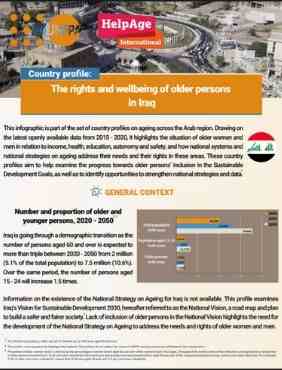
The rights and wellbeing of older persons in Iraq
These country profiles map the situation of older persons in five countries in the Arab region: Palestine, Iraq, Tunisia, Saudi Arabia and Egypt. The profiles were developed by HelpAge International with support from UNFPA Arab States Regional Office. They shed light on the situation of older women and men in relation to income, health, education, autonomy and safety, and highlight how national systems and strategies on ageing people address their needs and rights in these areas. The aim of these country profiles is to help monitor the progress achieved towards older persons’ inclusion in the Sustainable Development Goals, and identify opportunities to strengthen national strategies and data.
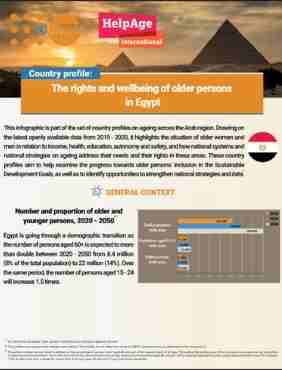
The rights and wellbeing of older persons in Egypt

The rights and wellbeing of older persons in Tunisia
These country profiles map the situation of older persons in five countries in the Arab region: Palestine, Iraq, Tunisia, Saudi Arabia and Egypt. The profiles were developed by HelpAge International with support from UNFPA Arab States Regional Office. They shed light on the situation of older women and men in relation to income, health, education, autonomy and safety, and highlight how national systems and strategies on ageing people address their needs and rights in these areas. The aim of these country profiles is to help monitor the progress achieved towards older persons’ inclusion in the Sustainable Development Goals, and identify opportunities to strengthen national strategies and data.

SITUATIONAL ANALYSIS OF WOMEN AND GIRLS IN THE MENA AND ARAB STATES REGION
The situation of women and girls in the Middle East and North Africa (MENA) and the Arab States region1 remains unresolved. Incremental progress has been documented, yet the pace is slow and does not reflect the commitments made to the Agenda 2030 and the Sustainable Development Goals, nor to address the challenges of the region.
As will be discussed, some progress related to gender equality and women’s and girls’ empowerment in several domains over the past decade has been witnessed. Within the region, laws, policies, and programming focused on gender equality are growing, women’s representation in government and in national programming has increased, and many countries have established national women’s machineries and other institutions that promote the rights and welfare of women and girls.
Areas such as education and health have seen significant improvement in gender-related indices, and specialized programming aimed at supporting women’s and girls’ rights and empowerment have accelerated in many countries in the region.
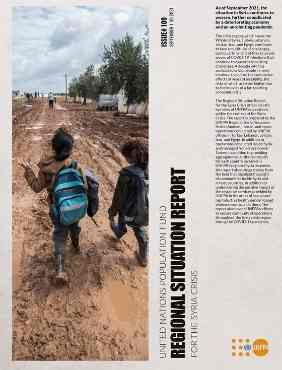
UNFPA Regional Situation Report for the Syria Crisis — September 2021
As of September 2021, the situation in Syria continues to worsen, further complicated by a deteriorating economy and an unrelenting pandemic. The crisis region, which spans the Whole of Syria, Turkey, Lebanon, Jordan, Iraq, and Egypt, continues to face a multitude of challenges, particularly in light of the recurrent waves of COVID-19 infections that continue to exacerbate existing challenges.
A decade into this protracted crisis, people in need continue to endure the cumulative effects of years of instability, the risks of which are even higher due to the impacts of a far-reaching economic crisis.
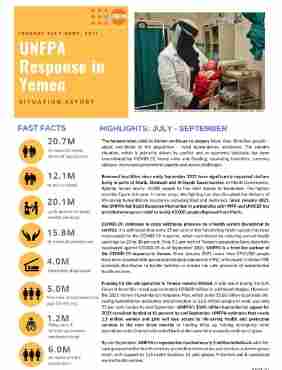
Yemen Response: Situation Report #02 July - September 2021
The humanitarian crisis in Yemen continues to deepen. More than 20 million people – about two-thirds of the population – need humanitarian assistance. The country situation, which is primarily driven by conflict and an economic blockade, has been exacerbated by COVID-19, heavy rains and flooding, escalating hostilities, currency collapse, decreased government capacity and access challenges. Renewed hostilities since early September 2021 have significantly impacted civilians living in parts of Marib, Shabwah and Al Bayda Governorates. In Marib Governorate, fighting forced nearly 10,000 people to flee their homes in September, the highest monthly figure this year. In some areas, the fighting has also disrupted the delivery of life-saving humanitarian assistance, including food and medicines. Since January 2021, the UNFPA-led Rapid Response Mechanism in partnership with WFP and UNICEF has provided emergency reliefto nearly 43,000 people displaced from Marib.
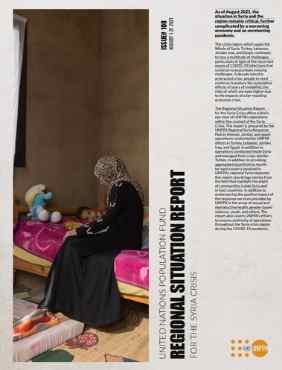
UNFPA Regional Situation Report for the Syria Crisis — August 2021
As of August 2021, the situation in Syria and the region remains critical, further complicated by a worsening economy and an unrelenting pandemic. The crisis region, which spans the Whole of Syria, Turkey, Lebanon, Jordan, Iraq, and Egypt, continues to face a multitude of challenges, particularly in light of the recurrent waves of COVID-19 infections that continue to exacerbate existing challenges. A decade into this protracted crisis, people in need continue to endure the cumulative effects of years of instability, the risks of which are even higher due to the impacts of a far-reaching economic crisis.